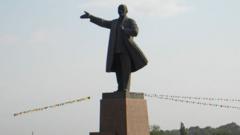The city of Osh in Kyrgyzstan recently dismantled the largest statue of Vladimir Lenin in Central Asia, a significant symbol erected during the Soviet era. Standing at 23 meters, this statue had been a prominent feature of the city for over 50 years. This week, images surfaced showing the statue being carefully lowered to the ground by a crane, illustrating the country's evolving relationship with its Soviet past.
The removal of the statue comes as Kyrgyzstan and other former Soviet republics aim to redefine their national identities, distancing themselves from historical ties to Russia. The local government played down the decision, emphasizing it was a routine effort to enhance the city's architectural landscape, while also acknowledging the potential diplomatic implications with Moscow, particularly after Russia erected a new statue of Joseph Stalin.
City officials state that the monument's location will give way to a new flagpole, similar to a previous initiative in the capital city, Bishkek. Despite Kyrgyzstan gaining independence over three decades ago following the dissolution of the Soviet Union, remnants of its Soviet past, including numerous statues and place names, continue to resonate within the nation's cultural fabric.
This dismantling of the statue is emblematic of Kyrgyzstan's ongoing journey towards embracing its unique identity while navigating the complex legacy of its history.
The removal of the statue comes as Kyrgyzstan and other former Soviet republics aim to redefine their national identities, distancing themselves from historical ties to Russia. The local government played down the decision, emphasizing it was a routine effort to enhance the city's architectural landscape, while also acknowledging the potential diplomatic implications with Moscow, particularly after Russia erected a new statue of Joseph Stalin.
City officials state that the monument's location will give way to a new flagpole, similar to a previous initiative in the capital city, Bishkek. Despite Kyrgyzstan gaining independence over three decades ago following the dissolution of the Soviet Union, remnants of its Soviet past, including numerous statues and place names, continue to resonate within the nation's cultural fabric.
This dismantling of the statue is emblematic of Kyrgyzstan's ongoing journey towards embracing its unique identity while navigating the complex legacy of its history.














